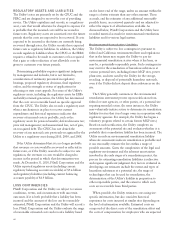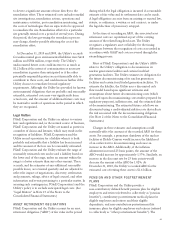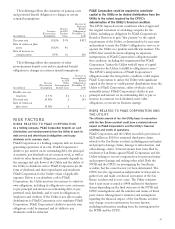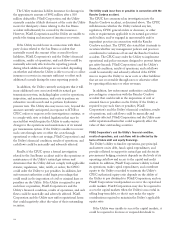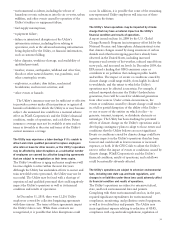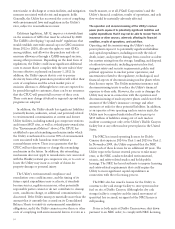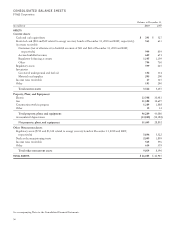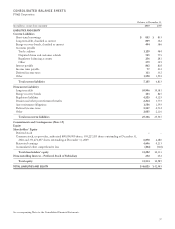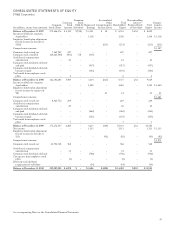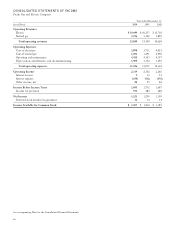PG&E 2010 Annual Report Download - page 54
Download and view the complete annual report
Please find page 54 of the 2010 PG&E annual report below. You can navigate through the pages in the report by either clicking on the pages listed below, or by using the keyword search tool below to find specific information within the annual report.and electricity procurement costs, PG&E Corporation’s and
the Utility’s financial condition, results of operations, and
cash flows could be materially adversely affected.
Electricity andnatural gas markets are highly volatile, and
regulatoryresponsiveness to that volatility could be
insufficient. Changing commodity prices may increase short-
term cash requirements.
Commodity markets for electricity and natural gas are
highly volatile and subject to substantial price fluctuations.
A variety of factors that are largely outside of the Utility’s
control may contribute to commodity price volatility,
including:
• weather;
• residential, commercial, and industrial demand;
• the availability of competitively priced alternative energy
sources;
• the level of production of natural gas and natural gas
supply availability, including inventory (storage);
• the availability of nuclear fuel;
• the availability of non-conventional natural gas supplies;
• the price of fuels that are used to produce electricity,
including natural gas, crude oil, coal, and nuclear
materials;
• the transparency, efficiency, integrity, and liquidity of
regional energy markets affecting California;
• electricity transmission or natural gas transportation
capacity constraints;
• federal, state, and local energy, and environmental
regulation and legislation; and
• natural disasters, war, terrorism, and other catastrophic
events.
The Utility’s direct exposure to natural gas price
volatility will increase as the DWR electricity purchase
contracts allocated to the Utility begin to expire or as the
DWR contracts are terminated or assigned to the Utility.
The final DWR contract is scheduled to expire in 2015.
Although the Utility attempts to execute CPUC-approved
hedging programs to reduce the natural gas price risk, these
hedging programs may not be successful or the costs of the
Utility’s hedging programs may not be fully recoverable.
Further, if wholesale electricity or natural gas prices
significantly increase, public pressure, other regulatory
influences, governmental influences, or other factors could
constrain the CPUC from authorizing timely recovery of
the Utility’s costs from customers. If the Utility cannot
recover a material amount of its costs in its rates in a timely
manner, PG&E Corporation’s and the Utility’s financial
condition, results of operations, and cash flows would be
materially adversely affected.
Economic downturn and the resulting drop in demand
for energy commodities has reduced the prices of electricity
and natural gas and required the Utility to deposit or return
collateral in connection with its commodity hedging
contracts. To the extent such commodity prices remain
volatile, the Utility’s liquidity and financing needs may
fluctuate due to the collateral requirements associated with
its commodity hedging contracts. If the Utility is required
to finance higher liquidity levels, the increased interest
costs may negatively impact net income.
The Utility’s financial conditionandresults of operations could
be materially adversely affected if it cannot successfully
manage the risks inherentinoperating the Utility’s facilities
andinformationsystems.
The Utility owns and operates extensive electricity and
natural gas facilities that are interconnected to the U.S.
western electricity grid and numerous interstate and
continental natural gas pipelines. These interconnected
systems are becoming increasingly reliant on evolving
information technology systems, including the
development of technologies and systems to establish a
“Smart Grid” to monitor and manage the nation’s
interconnected electric transmission grids. The Utility’s
wide deployment of an advanced metering infrastructure
throughout its service territory in California, in
combination with the system changes needed to
implement “dynamic pricing” for the Utility’s customers,
may increase the risk of damage from a system-wide failure
or from an intentional disruption of the system by third
parties. The operation of the Utility’s facilities and
information systems and the facilities and information
systems of third parties on which it relies involves
numerous risks, the realization of which can affect demand
for electricity or natural gas; result in unplanned outages;
reduce generating output; cause damage to the Utility’s
assets or operations or those of third parties on which it
relies; or subject the Utility to claims by customers or third
parties for damage to property, personal injury, or the
failure to maintain confidentiality of customer
information. These risks include:
• operating limitations that may be imposed by
environmental laws or regulations, including those
relating to GHG, or other regulatory requirements;
• imposition of stricter operational performance standards
by agencies with regulatory oversight of the Utility’s
facilities;
50


